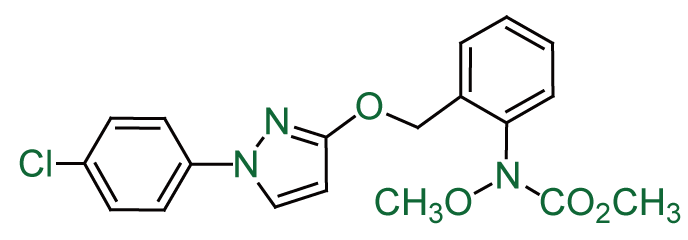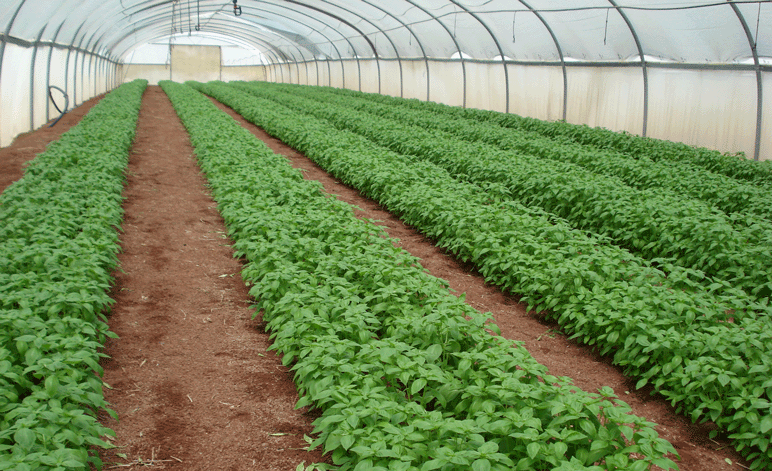- Azoxystrobin
- Bitertanol
- Captan
- Carboxin
- Carbendazim
- Cymoxanil
- Cuprous Oxide
- Copper Hydroxide
- Cyproconazole
- Cyprodinil
- Dimethomorph
- Diniconazole
- Difenoconazole
- Epoxiconazole
- Fluazinam
- Fludioxonil
- Fosetyl-aluminium
- Hexaconazole
- Imazalil
- Iprodione
- Kasugamycin
- Mancozeb
- Metalaxyl
- Metalaxyl-M
- Penconazole
- Propiconazole
- Prochloraz
- Propineb
- Pyraclostrobin
- Thiophanate-methyl
- Tebuconazole
- Tetraconazole
- Tricyclazole
- Triadimenol
- Triadimefon
- Tridemorph
- Trifloxystrobin
Pyraclostrobin
 other name: methyl [2-[[[1-(4-chlorophenyl)-1H-pyrazol-3-yl]oxy]methyl]phenyl]methoxycarbamate
other name: methyl [2-[[[1-(4-chlorophenyl)-1H-pyrazol-3-yl]oxy]methyl]phenyl]methoxycarbamate
CAS No.: [175013-18-0]
Molecular Formula: C19H18ClN3O4
Pyraclostrobin is a broad-spectrum fungicide, controlling major plant pathogens from the ascomycete, basidiomycete, deuteromycete and oomycete classes of fungi.
Pyraclostrobin has protective, curative, eradicative, translaminar and locosystemic properties. Pyraclostrobin is taken up rapidly by the plant and is largely retained by the waxes in the leaf cuticle. It demonstrates good translaminar movement through the leaf, resulting in disease control on both leaf surfaces. Acropetal and basipetal transport in leaves and vapour phase activity is very limited. Microscopic studies revealed that preventative treatments at concentrations of less than 0.1 ppm inhibit spore germination of a wide range of pathogens. The rapid uptake by the leaf and subsequent retention in the cuticular waxes means that applications are rainfast within 2 hours. After a curative or, against some diseases, an eradicative treatment, mycelium development is inhibited. Despite this post infection activity, the recommended use of pyraclostrobin will be preventative in accordance with the Fungicide Resistance Action Committee guidelines.
Pyraclostrobin is also reported to have beneficial effects on plant growth and yield and these are attributed to enhanced nitrate reductase activity leading to improved nitrogen assimilation during the stages of rapid crop growth and decreased ethylene production resulting in delayed senescence. Pyraclostrobin offers good to excellent control of most cereal leaf and ear diseases.

Biochemistry
Inhibits mitochondrial respiration by blocking electron transfer at the cytochrome bc1 complex.
Mode of action
Fungicide with protectant, curative, and translaminar properties.
Uses
Under development for control of major plant pathogens, such as Septoria tritici, Puccinia spp., and Drechslera tritici-repentis, Pyrenophora teres in cereals, Mycosphaerella spp. in peanuts, Septoria glycines, Cercospora kikuchii, and Phakopsora pachyrhizi in soya beans, Plasmopara viticola, Uncinula necator in grapes, Phytophthora infestans, Alternaria solani in potatoes and tomatoes, Mycosphaerella fijiensis in bananas, Elsino fawcettii, and Guignardia citricarpa in citrus and Rhizoctonia solani, and Pythium aphanidermatum in turf. Application rates are expected to be 50-250 g/ha for food crops and 280-560 g/ha for turf.
Formulation types EC; SE; WG.
GHS complaint Safety Data Sheet (SDS) for commercial product of Pyraclostrobin is available uopn requested.
